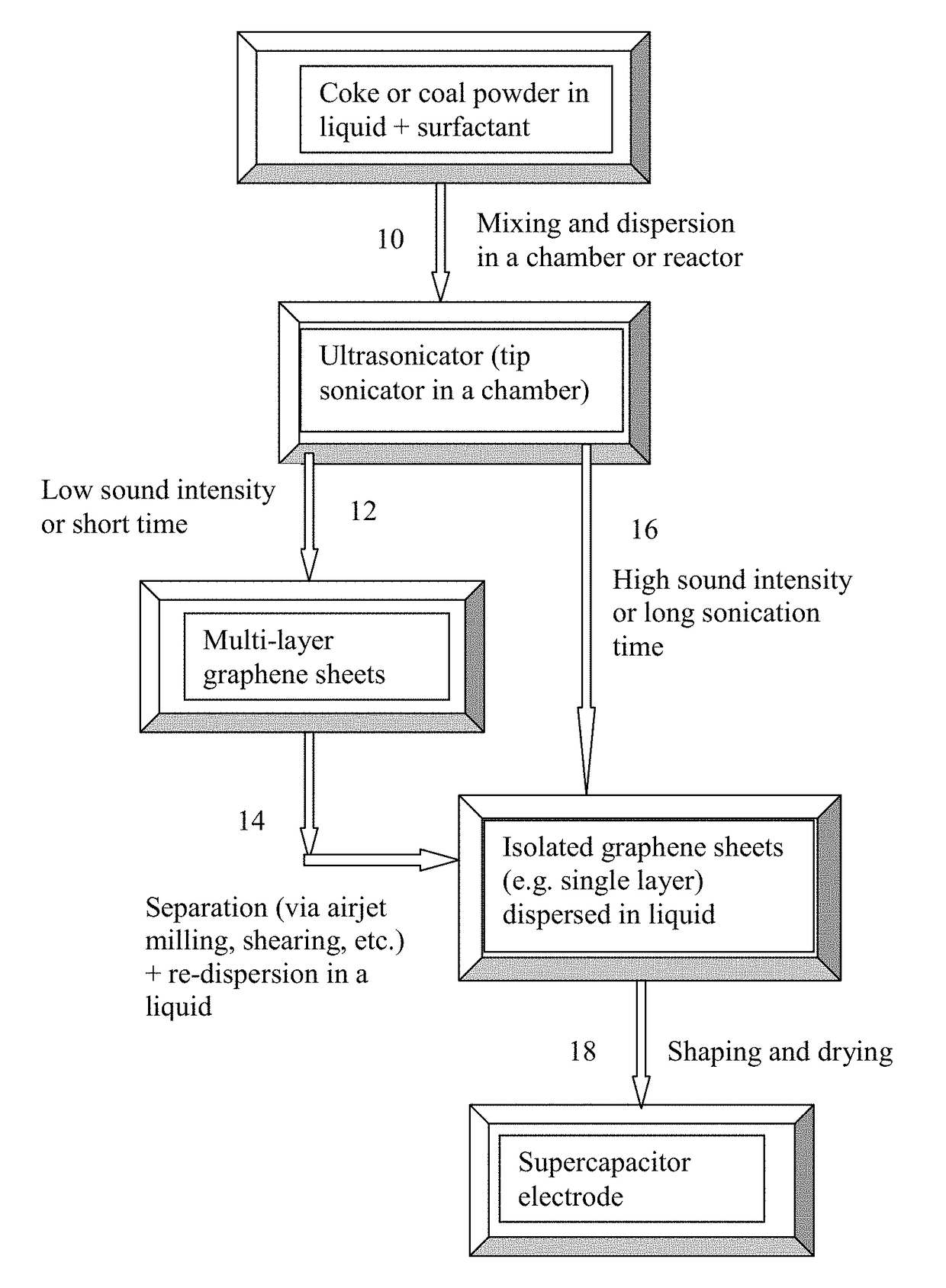Production of Graphene-Based Supercapacitor Electrode from Coke or Coal Using Direct Ultrasonication
- Summary
- Abstract
- Description
- Claims
- Application Information
AI Technical Summary
Benefits of technology
Problems solved by technology
Method used
Image
Examples
example 1
n of Graphene-Based Supercapacitor Electrodes from Milled Coal-Derived Needle Coke Powder
[0094]Needle coke, milled to an average length 2 / g, indicating that a majority of the graphene sheets being single-layer graphene, consistent with the microscopy results.
[0095]For the preparation of supercapacitor electrodes, various amounts (1%-30% by weight relative to graphene material) of chemical bowing agents (N,N-Dinitroso pentamethylene tetramine or 4. 4′-Oxybis (benzenesulfonyl hydrazide) were added to a suspension containing pristine graphene sheets and a surfactant. The suspension was then cast onto a glass surface using a doctor's blade to exert shear stresses, inducing graphene sheet orientations. Several samples were cast, including one that was made using CO2 as a physical blowing agent introduced into the suspension just prior to casting). The resulting graphene films, after removal of liquid, have a thickness that can be varied from approximately 10 to 500 μm.
[0096]The graphene ...
example 2
n of Graphene-Based Electrodes from Milled Coal-Derived Needle Coke Powder (No Dispersing Agent)
[0099]Five grams of needle coke from the same batch as used in Example 1 were dispersed in 1,000 mL of deionized water to obtain a suspension. An ultrasonic energy level of 85 W (Branson 5450 Ultrasonicator) was used for exfoliation, separation, and size reduction for a period of 2 hours. Various samples were collected with their morphology studied by SEM and TEM observations and their specific surface areas measured by the well-known BET method. The specific surface area of the produced graphene sheets are typically in the range of 240-450 m2 / g (mostly few-layer graphene). Certain amounts of the sample containing mostly multi-layer graphene sheets were then subjected to ultrasonication again to produce ultra-thin graphene sheets. Electron microscopic examinations of selected samples indicate that the majority of the resulting NGPs are single-layer graphene sheets.
[0100]A small amount of ...
example 3
n of Graphene-Based Electrodes from Milled Petroleum Needle Coke Powder
[0102]Needle coke, milled to an average length 2 / g (mostly single-layer graphene). Melamine appears to be the most effective dispersing agent, leading to the highest specific surface areas of graphene sheets. Products containing a majority of graphene sheets being single-layer graphene can be readily produced using the presently invented direct ultrasonication method.
[0103]The mixture was then sprayed onto a glass surface and the resulting graphene films, after removal of liquid, have a thickness of 150-1,200 μm. The graphene films were then subjected to heat treatments that involve a thermal decomposition temperature of 450° C. for 3 hours to remove melamine-derived volatile species. This treatment generated a layer of graphene foam as a supercapacitor electrode. The typical thickness is from 200 to 2,000 μm; there is no upper limit on the thickness of the supercapacitor electrodes prepared according to the inst...
PUM
| Property | Measurement | Unit |
|---|---|---|
| specific surface area | aaaaa | aaaaa |
| specific surface area | aaaaa | aaaaa |
| specific surface area | aaaaa | aaaaa |
Abstract
Description
Claims
Application Information
 Login to View More
Login to View More - R&D
- Intellectual Property
- Life Sciences
- Materials
- Tech Scout
- Unparalleled Data Quality
- Higher Quality Content
- 60% Fewer Hallucinations
Browse by: Latest US Patents, China's latest patents, Technical Efficacy Thesaurus, Application Domain, Technology Topic, Popular Technical Reports.
© 2025 PatSnap. All rights reserved.Legal|Privacy policy|Modern Slavery Act Transparency Statement|Sitemap|About US| Contact US: help@patsnap.com



